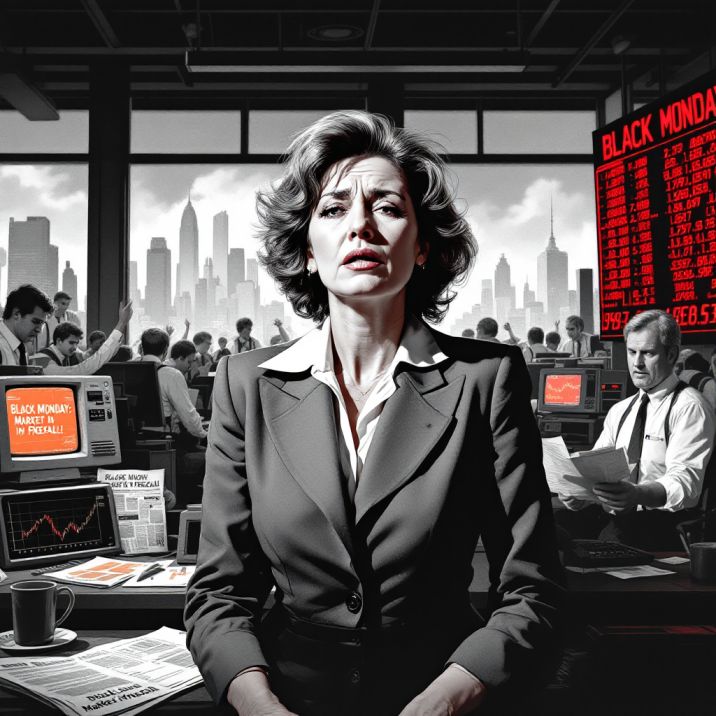
Black Monday 1987 Cause: Lessons in Stupidity and Greed
Nov 15, 2024
Introduction: The Perfect Storm of Folly and Excess
Black Monday, October 19th, 1987, is a stark reminder of the destructive power of stupidity and unchecked greed in the financial markets. It was a day when investors’ unchecked optimism and reckless behaviour led to a catastrophic Market crash, causing widespread panic and significant losses. In this essay, we will delve into the causes of Black Monday, exploring how mass psychology and technical analysis could have saved investors from ruin, and we will also examine the opportunities that arose for those with a keen eye and a contrarian mindset.
Stupidity and Greed – The Fuel for Disaster
The events leading up to Black Monday showcased the sheer stupidity and unfettered greed that often characterizes market participants. The herd mentality, or as we shall call it, the “dumb cow syndrome,” took over, and investors blindly followed the trend, ignoring warning signs and fundamental principles of investing. This section will discuss how the masses’ stupidity and greed set the stage for the impending disaster.
The “Dumb Cow Syndrome” and Mass Psychology
The period preceding Black Monday was marked by a speculative frenzy, with investors displaying a shocking lack of critical thinking and financial prudence. The “dumb cow syndrome” aptly describes the herd behaviour that took hold, as individuals blindly followed the crowd, buying stocks at inflated prices without conducting proper research or assessing risk. This mass psychology, driven by fear of missing out (FOMO) and a false sense of security, led to a dangerous disconnect from reality.
Ignoring the Warning Signs
Numerous warning signs indicated the market was due for a correction, yet investors ignored them. Valuations were stretched, price-to-earnings ratios were unsustainable, and market sentiment was overwhelmingly bullish. Contrarian indicators, such as the put-call ratio, flashed red, suggesting excessive optimism. However, the masses, driven by greed, disregarded these signs, believing the market would continue its upward trajectory indefinitely.
The Role of Greed
Unbridled greed fueled the speculative mania, as investors sought quick profits without regard for fundamental value. Margin debt, a measure of borrowed money used to purchase stocks, soared, indicating that investors were leveraging their positions to maximize gains. This reckless borrowing amplified the eventual losses when the market turned downward. Greed clouded investors’ judgment, leading them to make irrational decisions and ignore the inherent risks of their actions.
Could Mass Psychology and Technical Analysis Have Saved the Day?
Investors became complacent as the market climbed higher and failed to employ proper risk management strategies. This section will explore how combining mass psychology and technical analysis could have helped investors avoid and profit from the crash.
Reading the Crowd’s Mood
Mass psychology, the study of crowd behaviour, could have provided valuable insights into the market’s direction. By analyzing investor sentiment and market moods, contrarian investors could have identified the excessive optimism and growing complacency as signs of an impending reversal. Indicators such as investor surveys, market breadth, and sentiment indicators like the VIX “fear gauge” could have signalled the heightened risk of a market downturn.
Technical Analysis – A Powerful Tool
Technical analysis, the study of price movements and market trends, offered a more objective perspective. Chart patterns, such as the rising wedge formation, and technical indicators, like the Relative Strength Index (RSI) and moving averages, could have signalled the market’s overbought conditions and a potential reversal. The divergence between stock prices and declining trading volume was another red flag that technical analysts might have spotted, suggesting a lack of conviction behind the rally.
Contrarian Strategies and Risk Management
Combining mass psychology insights with technical analysis, astute investors could have implemented contrarian strategies. This would have involved taking profits before the crash, hedging their portfolios using put options or other derivatives, and setting stop-loss orders to limit potential losses. By recognizing the crowd’s excessive optimism and the technical indicators flashing red, investors could have preserved their capital and avoided the brunt of the crash.
Jumping In After the Crash – The Courage to Contrarian
Black Monday presented a unique opportunity for those brave enough to go against the tide. This section will discuss how investors could have used mass psychology and technical analysis to identify the buying opportunity that followed the crash.
Crowd psychology again played a crucial role as panic gripped the markets after Black Monday. Investor sentiment turned overwhelmingly bearish, with fear and pessimism dominating the mood. However, this presented a classic contrarian investing opportunity. Legendary trader Jesse Livermore, known for profiting from market crashes, famously said, “I never buy at the bottom, and I always sell too soon.” Livermore understood the power of buying when others were fearful, a strategy that could have been applied significantly after Black Monday.
This mindset aligns closely with the philosophy of another influential trader, Paul Tudor Jones, who successfully capitalized on the 1987 downturn. Jones once remarked, “When you see a bubble, you know it will burst. The trick is to get out before it does.” His ability to anticipate market reversals and his disciplined approach to trading allowed him to exploit the extreme conditions post-crash. By understanding the psychological shifts in the market and using technical signals to guide entries and exits, savvy investors like Jones navigated the volatile waters of post-crash investing, turning a potential disaster into substantial profit.
Technical Analysis and the Art of Bottom-Picking
Technical analysis tools could have helped identify attractive entry points after the crash. Indicators such as the Relative Strength Index (RSI) reaching oversold levels, bullish candlestick patterns, and volume surges signalling accumulation could have signalled potential buying opportunities. The concept of “catching a falling knife” applies here, as brave investors who bought when prices plummeted stood to gain significantly as the market eventually rebounded.
A Top Trader’s Perspective – Riding the Wave of Recovery
Let’s consider the approach of a top trader who benefited from the 1987 crash, such as George Soros or Paul Tudor Jones. These traders likely employed a combination of fundamental analysis and technical prowess. They would have assessed the market’s oversold conditions, identified attractive valuations, and used technical indicators to time their entries. By doing so, they could have positioned themselves to profit from the subsequent market recovery, showcasing the importance of a disciplined and strategic approach to investing.
Paul Tudor Jones, a renowned hedge fund manager, successfully navigated the 1987 crash and emerged with substantial profits. In an interview with Tony Robbins, Jones shared his insights on the event, stating, “I had been expecting a crash for a long time. I was very bearish on the market.” Jones’s contrarian stance and ability to anticipate the market’s direction allowed him to capitalize on the opportunity presented by the crash.
Jones’s approach involved a combination of technical analysis and risk management. He closely monitored market trends, looking for signs of weakness and potential reversal points. By employing strict risk management techniques, such as setting stop-loss orders and maintaining a diversified portfolio, Jones could limit his downside exposure while positioning himself to benefit from the market’s eventual recovery.
In the aftermath of the crash, Jones recognized the potential for a significant market rebound. He noted, “The crash created an unbelievable buying opportunity. The market had become incredibly oversold, and there was a lot of value to be found.” By identifying undervalued stocks and using technical indicators to time his entries, Jones was able to ride the wave of recovery and generate substantial returns for his investors.
Jones’s success during the 1987 crash highlights the importance of maintaining a disciplined and adaptable approach to investing. By combining fundamental analysis, technical expertise, and robust risk management, top traders like Jones navigated the market turmoil and emerged with impressive gains.
As Jones stated, “The key to trading success is emotional discipline. If intelligence were the key, there would be a lot more people making money trading.” This quote underscores the significance of remaining level-headed and sticking to one’s investment strategy, even in market chaos.
The lessons learned from the 1987 crash and the success of traders like Paul Tudor Jones are valuable reminders for investors today. By employing a disciplined approach, utilizing technical analysis, and maintaining emotional control, investors can position themselves to capitalize on market dislocations and ride the wave of recovery, just as Jones did in the aftermath of Black Monday.
Conclusion: Learning from Stupidity and Greed – A Path to Investing Wisdom
Black Monday 1987 is a valuable lesson in the financial markets’ dangers of stupidity and greed. By understanding the causes and dynamics of this event, investors can develop a more disciplined and prudent approach to investing.
Emotional discipline is crucial to avoiding the pitfalls of stupidity and greed. Investors must recognize and control their emotions, avoiding the herd mentality that often leads to poor decision-making. Developing a structured investment strategy based on fundamental and technical analysis can help investors make rational choices, even amid market turmoil.
Black Monday underscores the value of contrarian thinking. Investors can exploit market dislocations and identify profitable opportunities by going against the crowd and buying when others are fearful. This requires courage and a firm conviction in one’s investment strategy.
Technical analysis is a powerful tool for risk management. By understanding price patterns and market trends, investors can set stop-loss orders, limit potential losses, and identify attractive entry and exit points. Combining technical analysis with a contrarian mindset can enhance one’s ability to navigate market crashes and exploit subsequent buying opportunities.
Jesse Livermore once said, “It never was my thinking that made the big money for me. It always was my sitting.” Learning from history and adopting a thoughtful, contrarian approach can lead investors toward wisdom and success in the volatile world of finance. In conclusion, Black Monday 1987 was a stark reminder of the destructive consequences of stupidity and greed in the financial markets.
Timeless Tales: From Classics to Now














